
Relaxing in M'Hamid
Relaxing Days in M'Hamid el Ghizlane
Sahara DreamsDesert Trips
I was nearing the end of a four-week visit to Morocco.
I had been to the imperial cities of
Fez,
Meknès,
and
Marrakech,
and to intrigue-haunted
Tangier.
I wanted to visit M'Hamid,
and venture on into the desert if that would be practical.
But I also wanted to just take it easy for a few days.
This was an excellent place to do that.
I had arrived in a shared car from Zagora,
one hundred kilometers to the north.
The car had let us out in the standard place,
actually marked on Google Maps as if it were a bus terminal
when it's really no more than an open lot
near the center of town.
From there to my guesthouse it was
a little under a kilometer on foot,
across the broad arid Draa wadi and south along a lane.
On this map M'Hamid is shown along the north edge of the
date palm oasis.
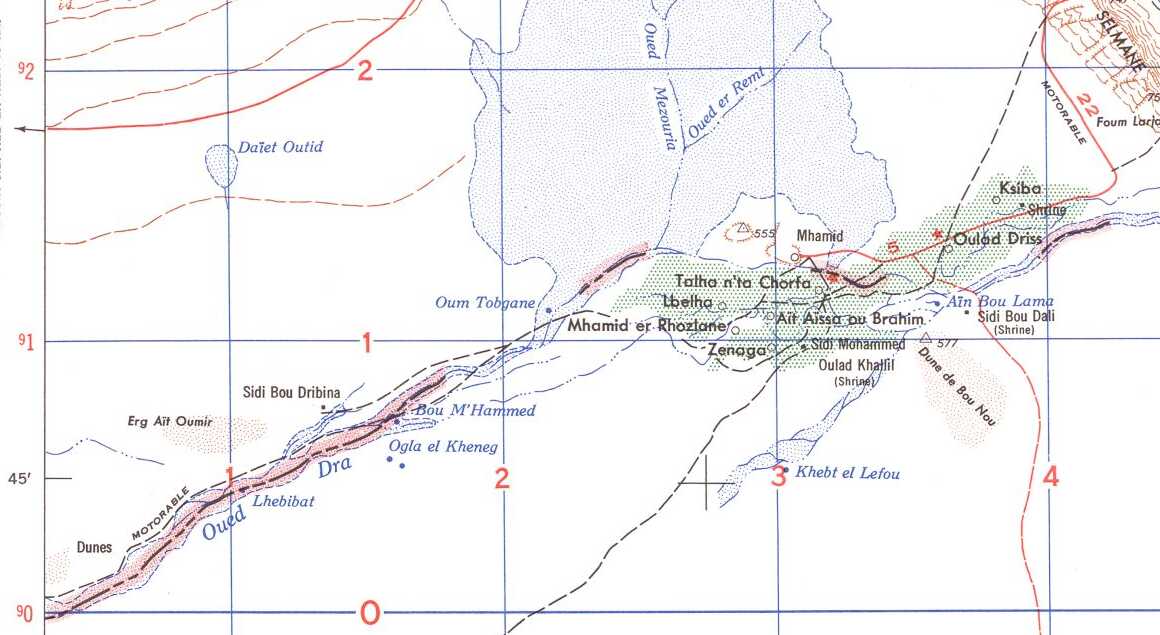
Portion of 1953 U.S. Army 1:250,000 map NH30-9 from the Perry-Castañeda Library Map Collection at the University of Texas at Austin. The black grid is 10×10 km squares.
Arrival
The guesthouse, like so many places in Morocco, is built like a fort. Here I'm stepping through the gate from the lane. A group has just returned from a desert expedition.
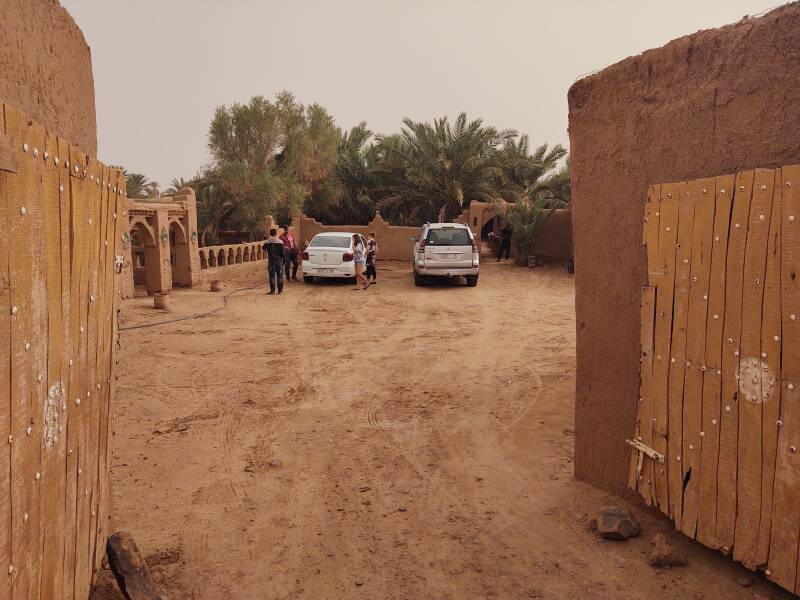
I had reserved a room here, at the Auberge la Palmeraie.
This is the gate into its central area. Everything is built like a ksar or a kasbah, a fortification.
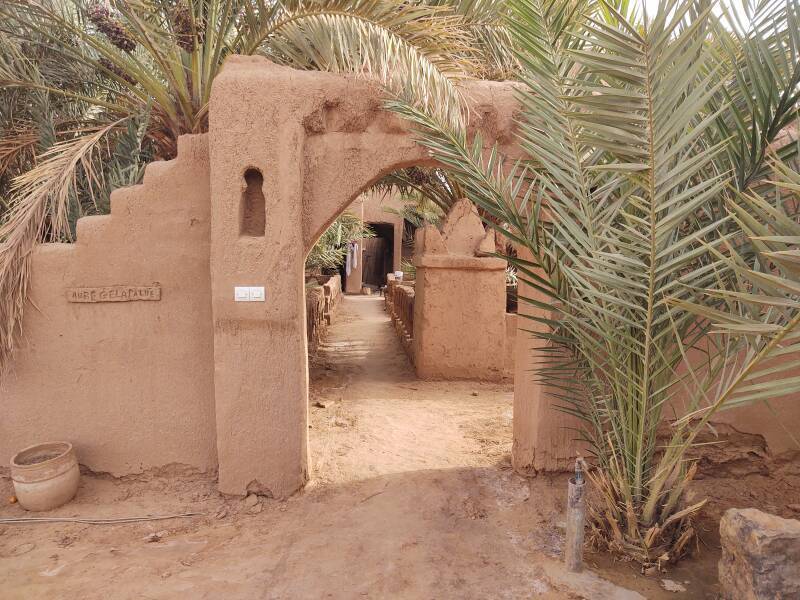
This is the headquarters and front desk.
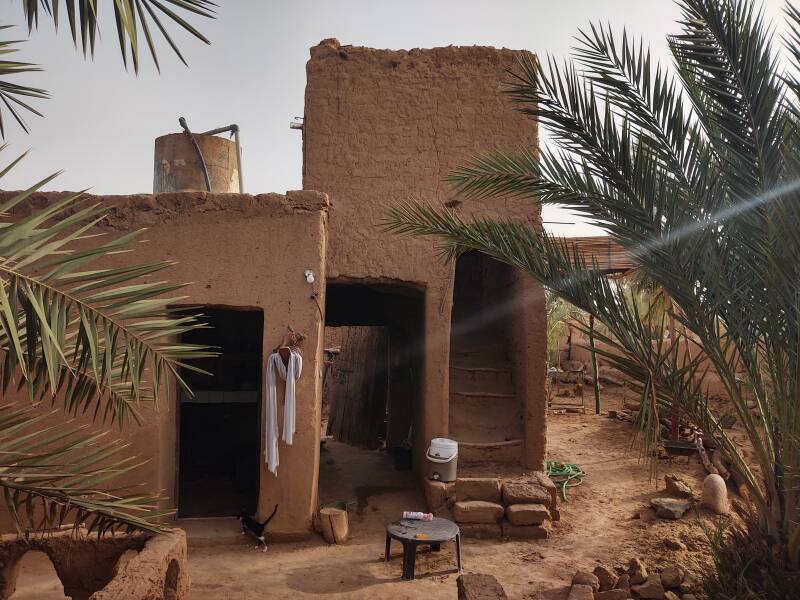
Several tents are available for resting, talking, having a meal.
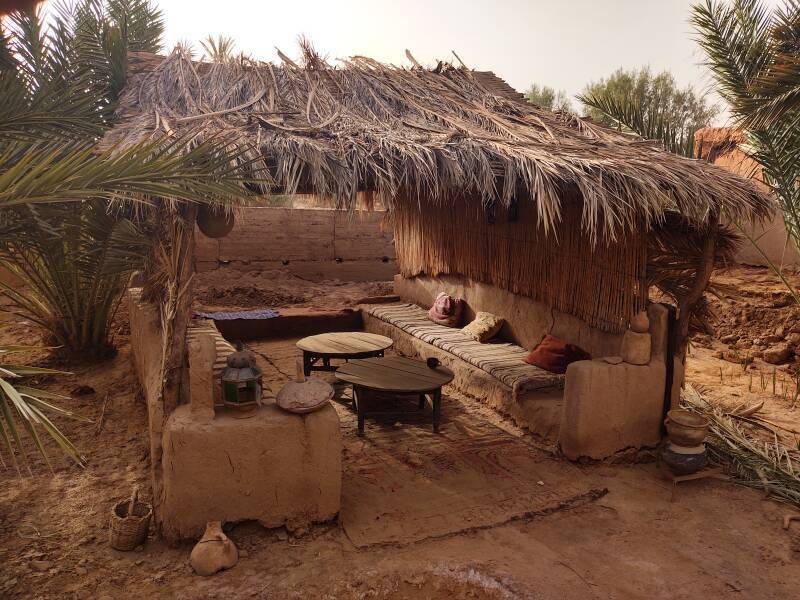
My room is the middle door along this side of the main building.
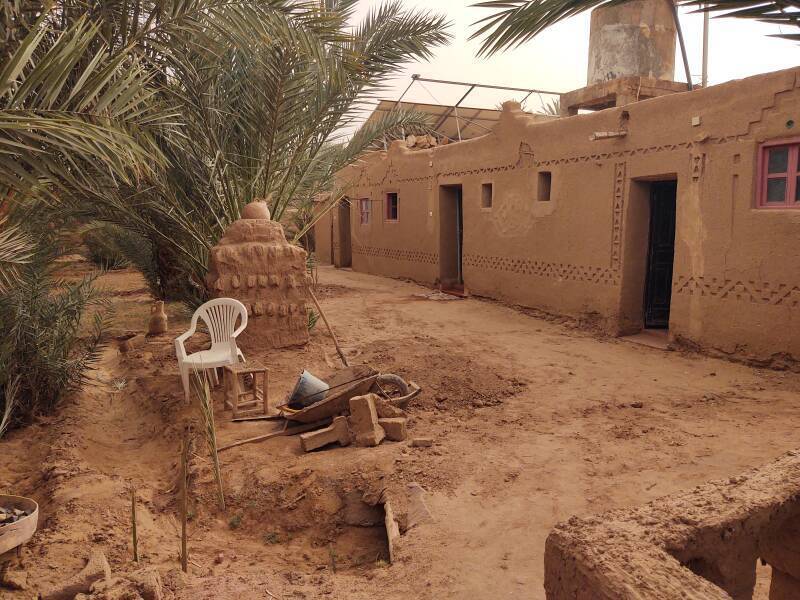
My Room
My room at Auberge la Palmeraie was just 85 Dirham a night, about US$ 8 including the added tax.
Booking.com had sent many notifications, their usual frantic blizzard, including one reporting that I could upgrade to an en suite room here, one with its own bathroom, for just an additional US$ 2 per night.
And so I did. It would have been 65 Dirham or US$ 6 per night with shared plumbing. Shared would have been OK, but the upgrade was only US$ 2 per night. Post-trip calculations showed that my lodging averaged US$ 17 per night for the four weeks in Morocco. The supposedly high price is due to all the optional bathrooms.
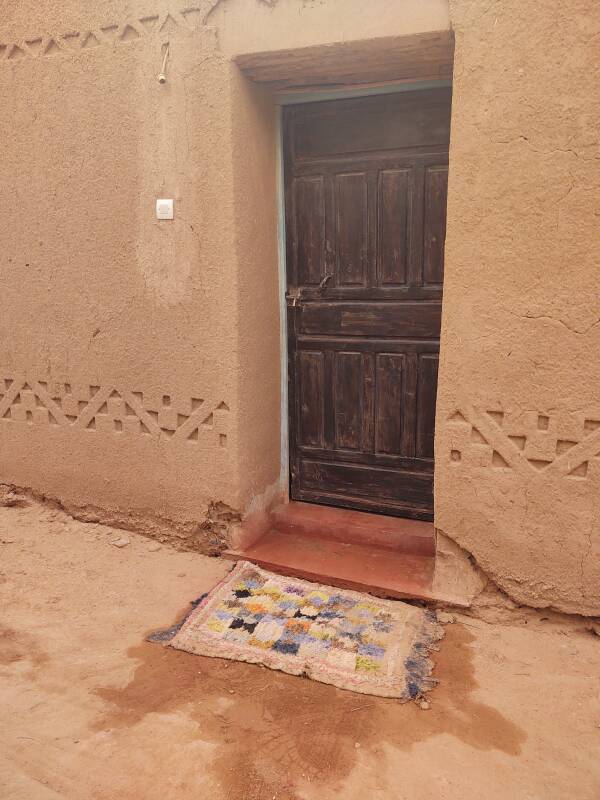
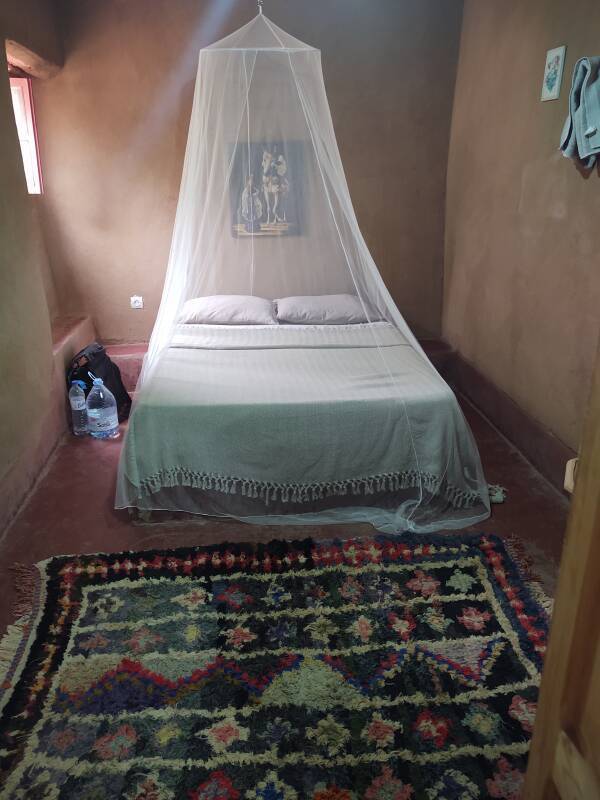
The window was just an opening, no glass or screen and not perfectly sealed even with the wooden shutter closed. The Draa wadi is quite dry, the entire area is arid, but still there are mosquitos at night. The mosquito net was essential.
I am as deep into Berber country as you get in Morocco, so of course that's a real Berber carpet on the floor.
Notice my water supply in the above picture. That's a 1.5-liter bottle I had brought with me in the shared car, and a 5-liter jug I bought at a shop in the center of town as soon as I got settled in here.
The view from beside the bed shows the shelves with my pack, and the door into the bathroom.
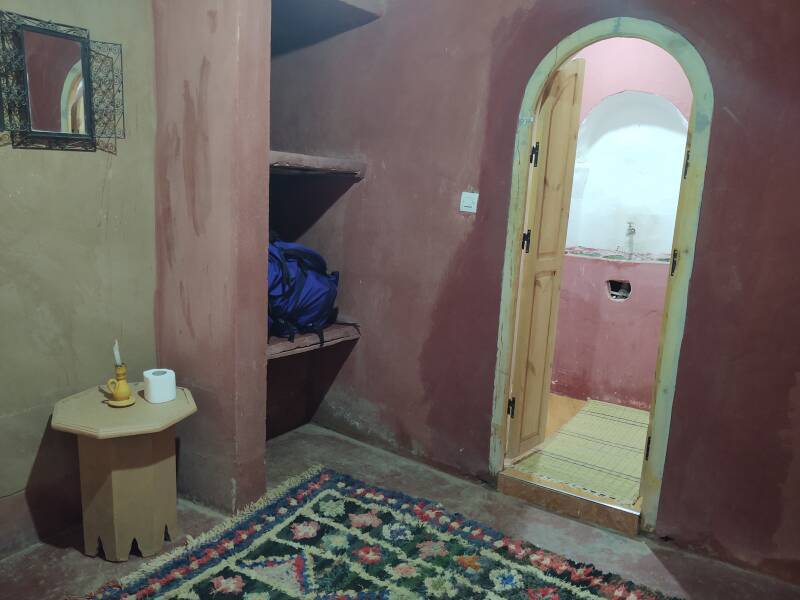
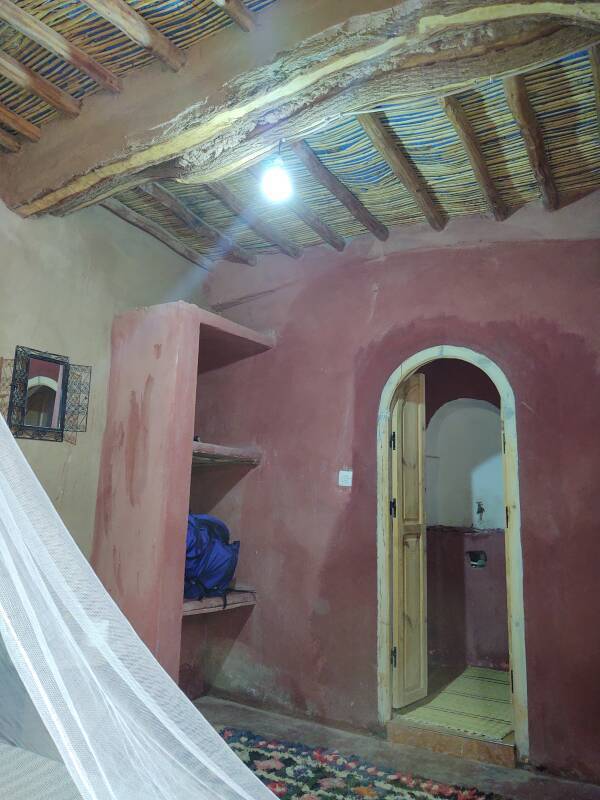
Lighting in Morocco was almost entirely LED-based when I visited in 2022. Most of it was a very hot blue shade, well over 5000 K. For some reason, tobacco shops in the U.S. go for that harsh hue of illumination.
I had my own toilet and shower.

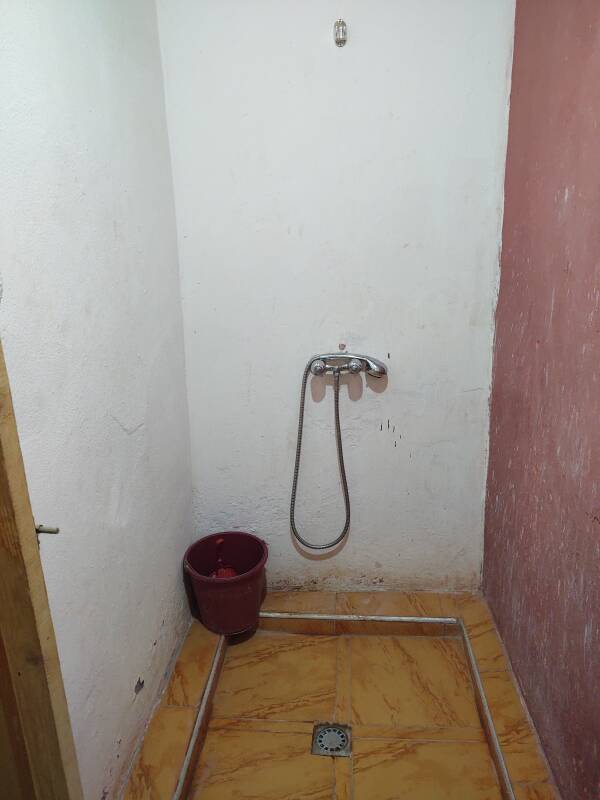
Back in Zagora, my innkeeper there had told me about the recent water table changes in that area.
The Arabic word وَادِي or وَاد is Romanized wādī for English speakers, or oued and ouadi in French maps and books. It refers to a valley that may be a riverbed that only contains water after infrequent heavy rainfall.
The Draa is Morocco's longest river, at 1,100 kilometres. But for much of it, there's no visible water at all. It's a wadi, a dry channel only infrequently holding visible water. It does carry some water, the ground moisture is higher along the wadi's path. That supports a series of date palm oases from Agdz southeast through Tamezmoute, on to Zagora, then south through the last three at Tamgrout, Tagounite, and M'Hamid.
The Draa starts in the mountains and runs southeast to Tagounite. There it is in its nearly 180° turn to the south and then west to run to the Atlantic Ocean just north of Tan-Tan. It looks like what I would think of as a river once it gets close to its end, with visible water and everything.
Now the water supply is rapidly dropping further. The agricultural zone along the wadi has averaged about 3 kilometers wide but it is now shrinking.
My Zagora innkeeper told me that in the 1990s you would almost always hit water when you drilled down only 10 meters close to the Draa wadi. But, by 2022, you had to drill at least 100 meters to hit water. Sometimes you might drill as deep as 200 meters and still not hit any water.
Back in Zagora the tap water had been a little brackish. You wouldn't want to drink much of it, but it was fine for brushing your teeth.
The limited groundwater remaining at M'Hamid is very salty. I'm sure that local people have become accustomed to it. But for me, not having grown up camping beside the ocean, the tap water was too salty for brushing my teeth.
I had anticipated that, buying the first of my five-liter jugs the first afternoon, before I had tried brushing my teeth. All accommodations in town would have salty water like this, because everything had to connect to the one available source.

On the Net
Do They Have Electricity In France?As I have witnessed, some Americans who watch nothing but Fox "News" (and now even worse, like Newsmax and OAN), come to believe some strange things.
For example, while Paris is known as "The City of Lights", Fox-watchers may become certain that outside Paris and maybe one other city there is no electrical supply in France. People in most of the country have to use candles and lanterns to see anything at night, or so they have been led to believe by Rupert Murdoch's disinformation machine.
Since they're watching Tucker Carlson's White Power Hour every night, I don't want to think about what they believe about Morocco.
Here's my laptop, with its tired battery that needed to be plugged in most of the time. I'm on the net!
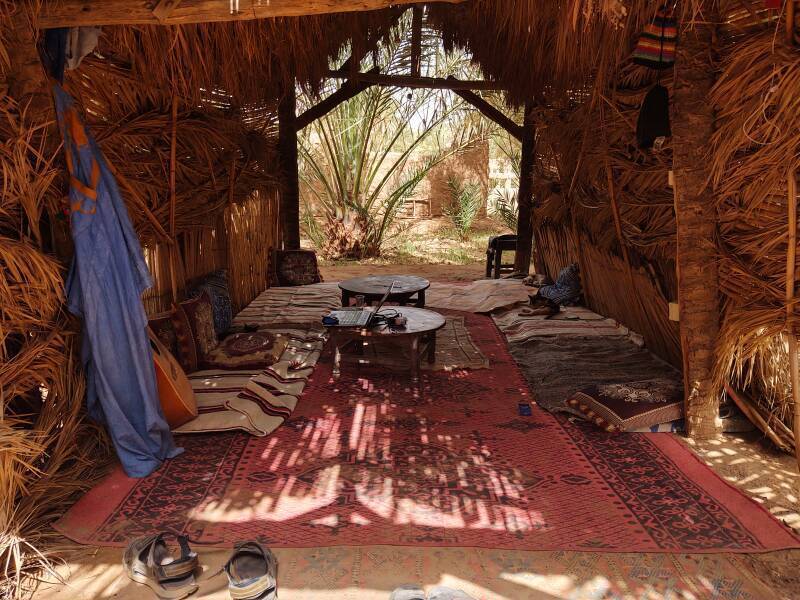
Of course there is reliable electrical power in M'Hamid. This is the national grid that incorporated the world's largest CSP or concentrated solar power generating station in 2019. Small nearby villages of Bounnou and Zaouîat Moulay Mbark were electrified in 1999, but M'Hamid has been on the national grid much longer.
The wireless connectivity was great.
Fibre runs along the highway to M'Hamid. DNS seemed to cause some initial connection delay, but otherwise I thought it was excellent connectivity for being beyond the south end of the pavement.
It was peaceful. I could sit and watch the cats watching the garden.
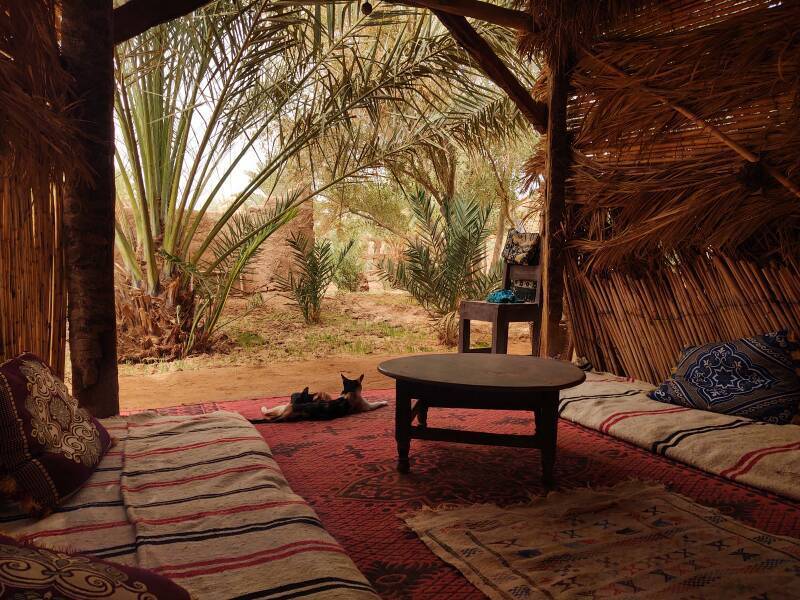
A map in the tent showed details of the 60-kilometer trip to Erg Chigaga.
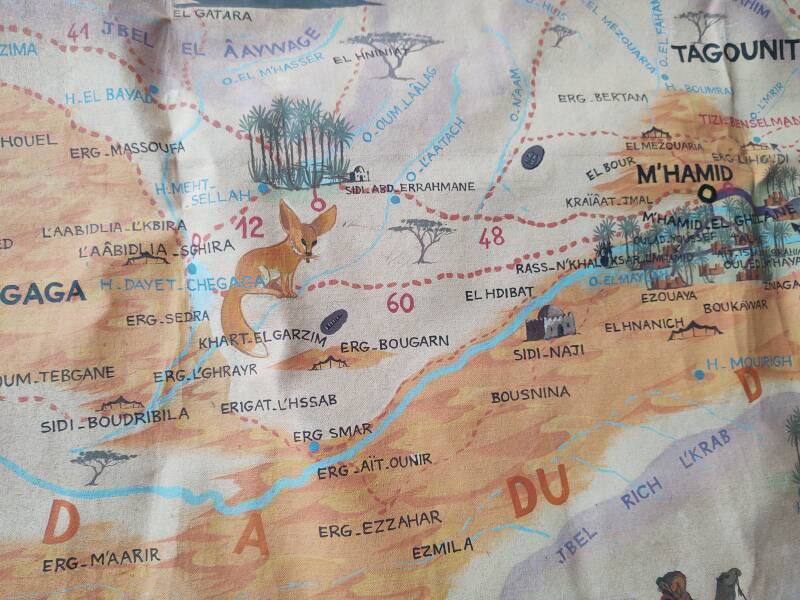
Courtyard
The auberge included bungalows and seating around a courtyard.
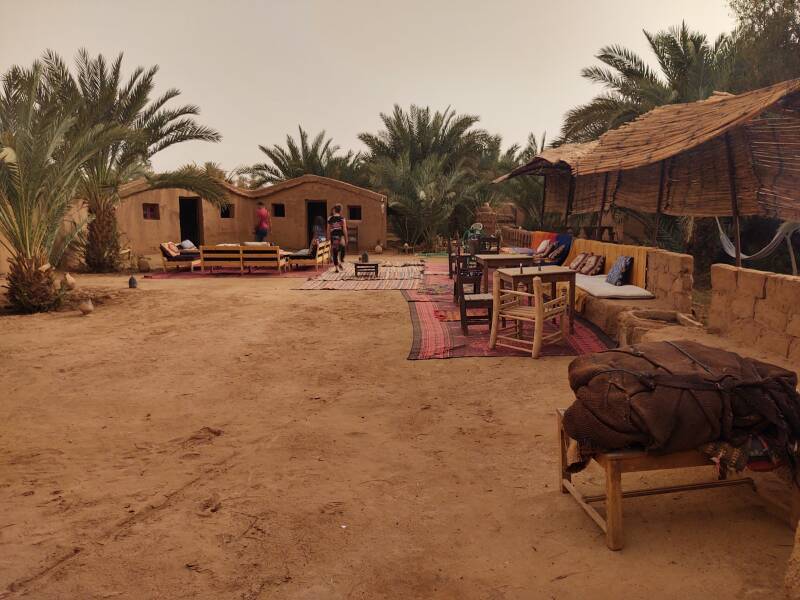
Two families were staying in the bungalows.
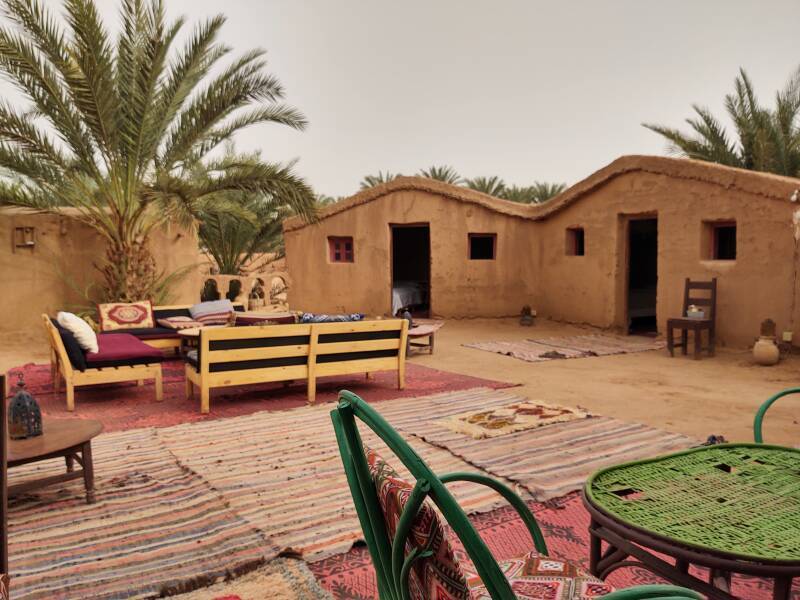
Dinner was served here, and it was a pleasant place to sit in the afternoon when the sun had moved far enough for the long couches to be shaded.
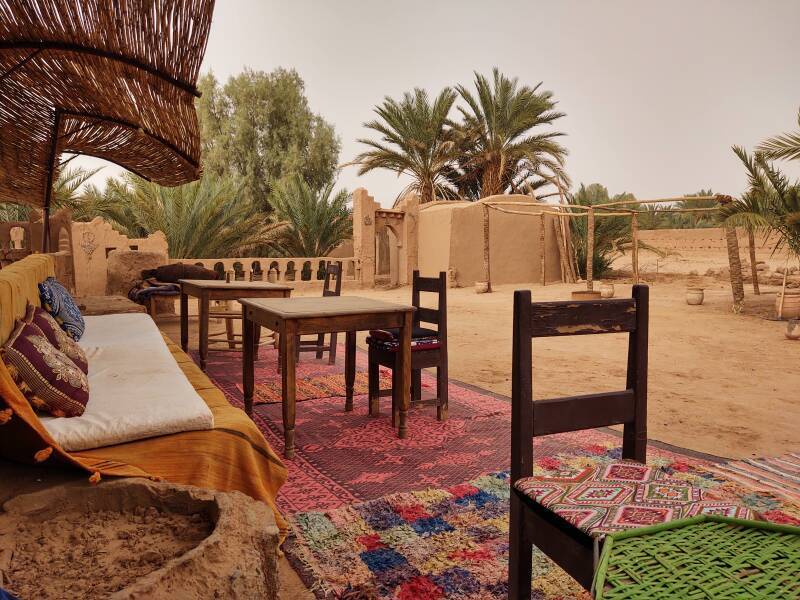
I finished reading Alan Furst's Dark Voyage. Significant sections of the story take place in Tangier.

Dinner and a Show
Dinner was fantastic. On this night it was chicken tajine with salad and bread.
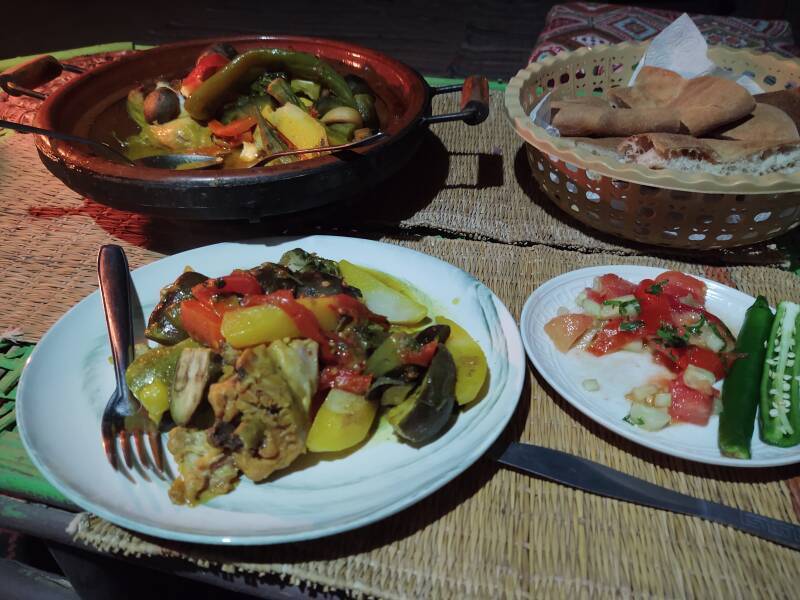
And then, the music!
Ibrahim was in charge of the place, and his cousin Muhammad, in the light blue here, helped to run the auberge. Two friends came over one evening for a jam session with Muhammad.
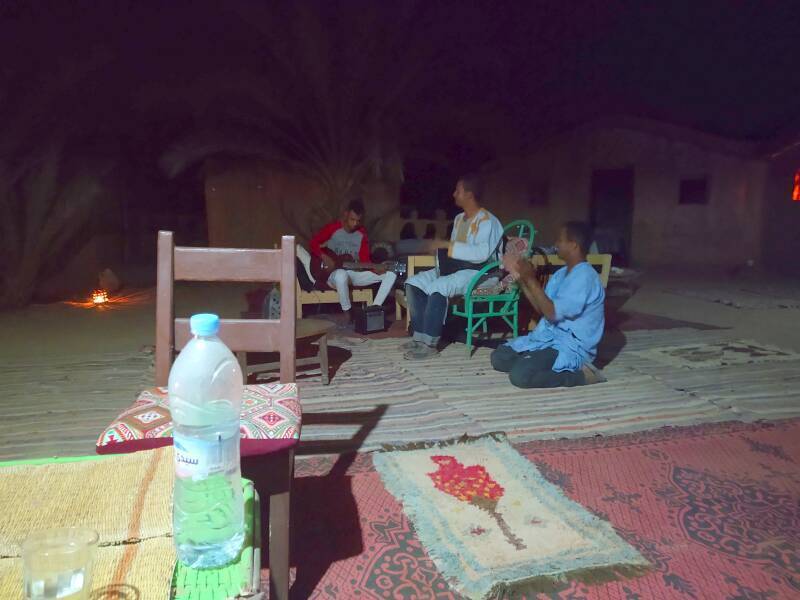
One friend had an electric guitar with some effects boxes, the other had an acoustic guitar, and Muhammad was on the drum.
And then after a few songs they would exchange instruments.
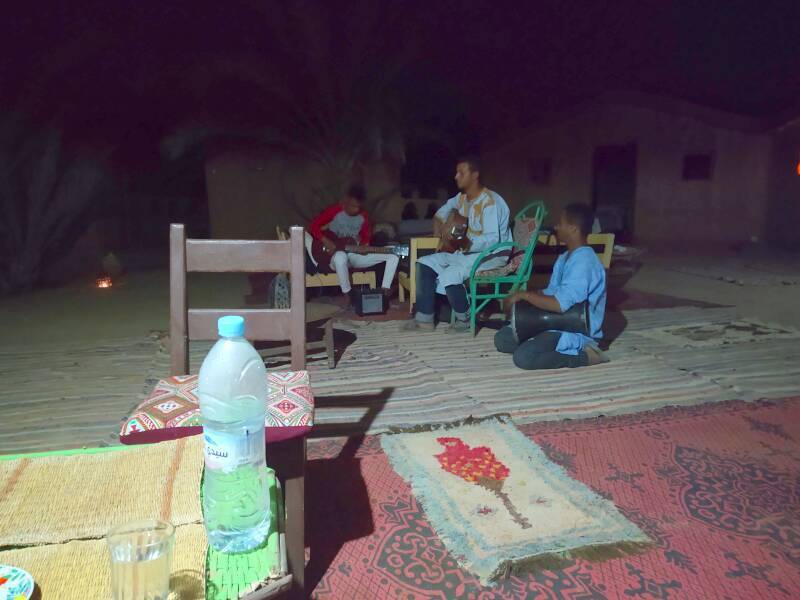
Joe Strummer, who wrote the lyrics to Rock the Kasbah knew of what he wrote. The opening lines are:
You have to let that raga drop
Yes, the electric guitar was doing some very sitar-like things. The music here was truly raga-like.
Many classic rock artists and other musicians of the 1960s and 1970s traveled to Morocco. Keith Richards, Mick Jagger, Jimmy Page, Robert Plant, Jimi Hendrix, members of Pink Floyd, members of Jefferson Airplane, Frank Zappa, Paul Simon, Cat Stevens, and many others spent time in Morocco. They met and played with local musicians. Those based around London were just a three to four hour flight away from Morocco.
In 1994 Jimmy Page and Robert Plant recorded their No Quarter album, recording part of it on the Jama'a el-Fnaa square in Marrakech along with several Moroccan musicians.
Maintenance and Irrigation
I was relaxing, sitting in one of the tents. I heard a thump ... thump ... thump ...
It sounded a little like someone throwing an inflated ball against a wall, a basketball or similar, without any sound of it bouncing its way back to them for another throw.
It wasn't at all annoying, but it was curious.
At some point I got up to get one of my water bottles from my room. But first I would look for the source of the sound.
Ah! It was two guys building a rammed-earth wall for a new bungalow.
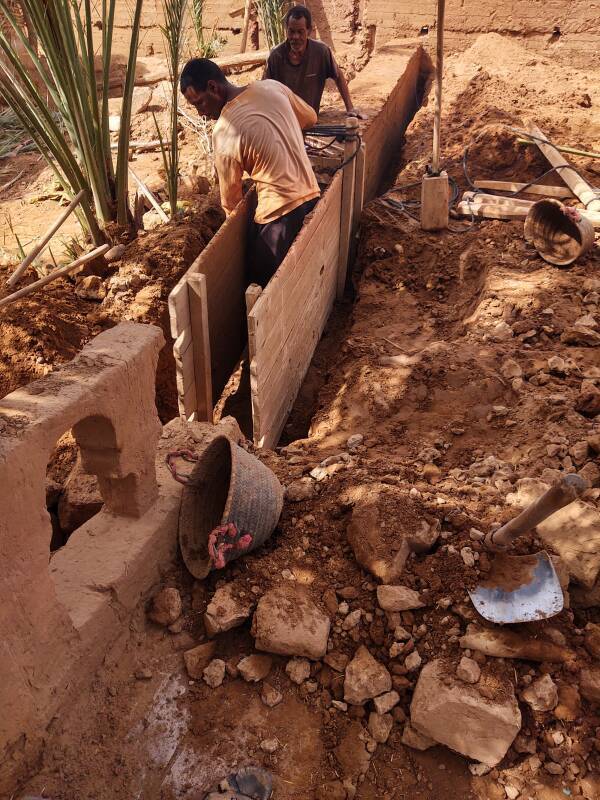
They had a very effective and efficient system of forms.
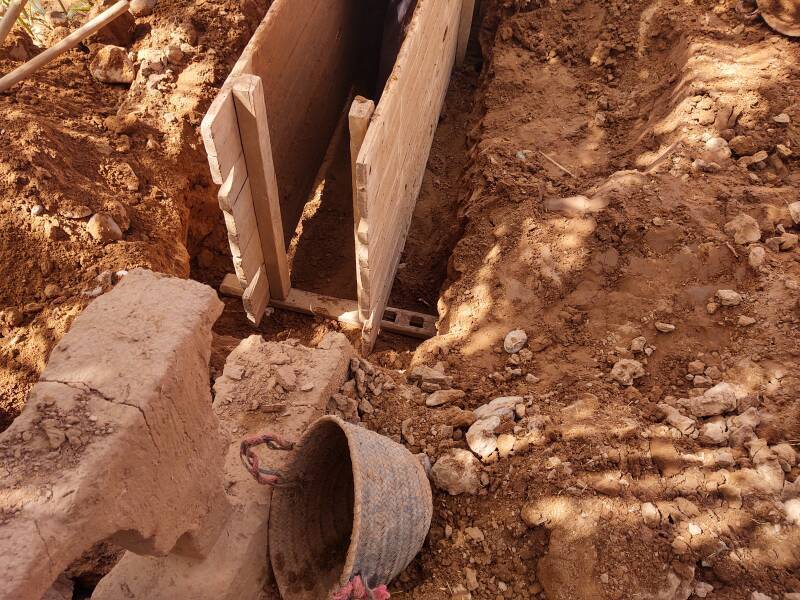
They would ram a mixture of mud and straw down between the forms of one section. Then they could rearrange the parts to extend the form and the wall into the next section.
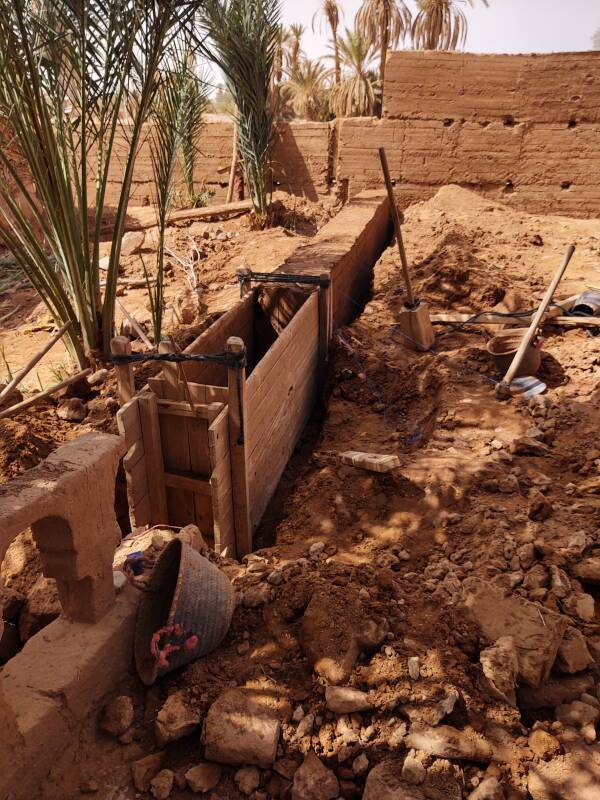
By the next day they had finished the foundation layer of the first wall, built all of that for the second wall, and done some other work on the project not visible here.

Ibrahim and Muhammad pump water into some channels and irrigate the palms and garden.

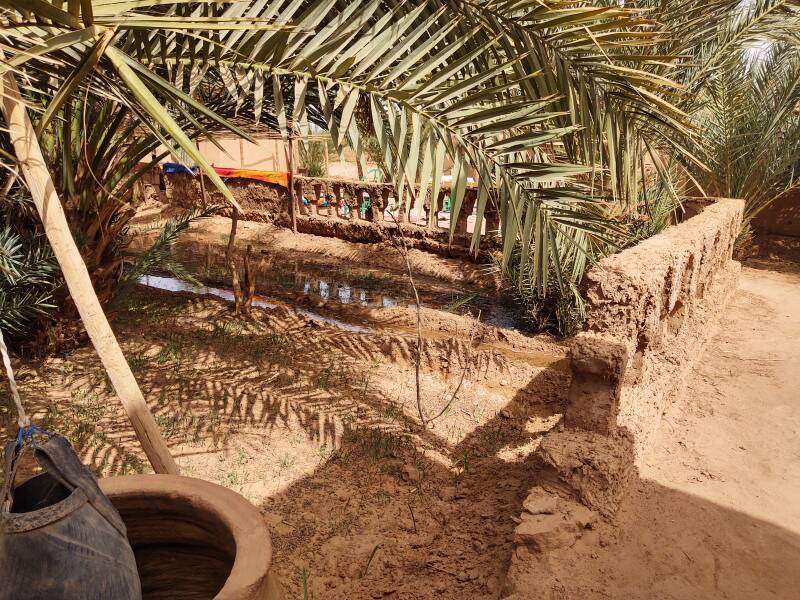
The garden must contain salt-tolerant strains of plants.
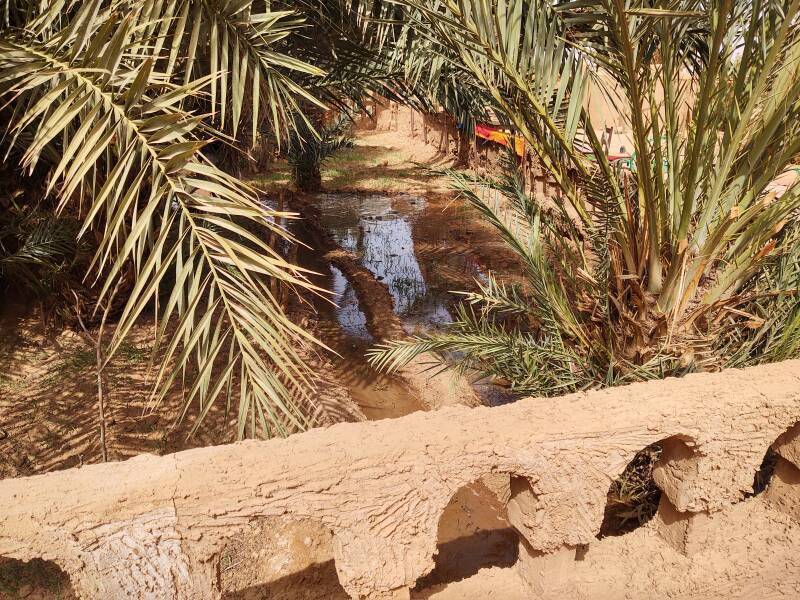
Agriculture, never easy in this area, is growing harder with the increasing salinity of the ground water.
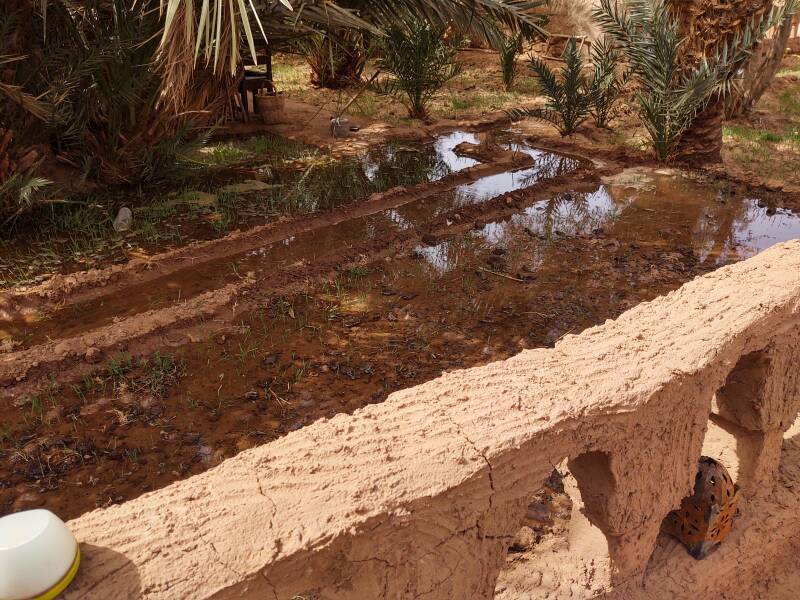
Khettara or qatarra, irrigation tunnels known as qanat far to the east, have been used for irrigation for centuries in this area.
Much more recently, Frank Herbert used the original Persian name in his Dune series of novels.
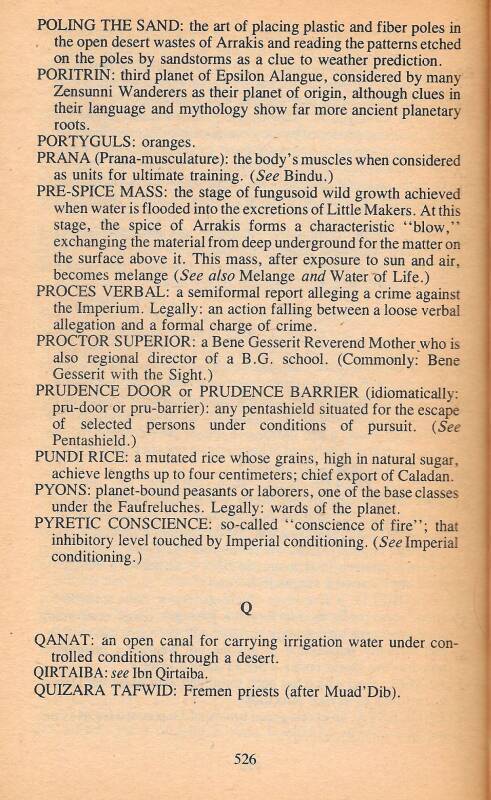
Glossary of Frank Herbert's Dune.
The next page visits the town of M'Hamid.
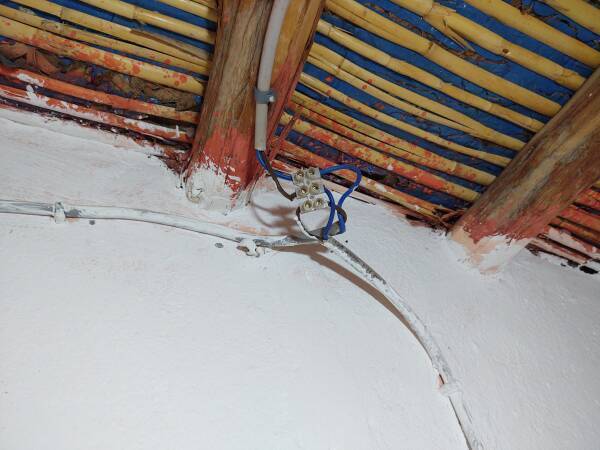
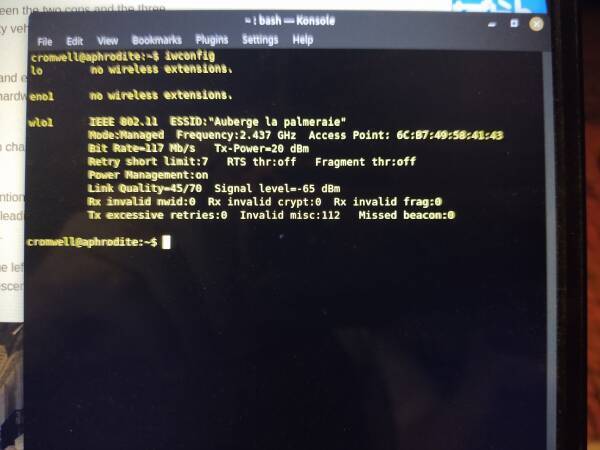
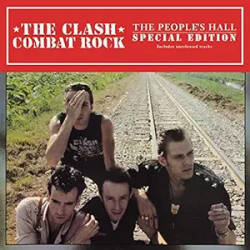


At the time:
1 Dirham = 0.093 US$
10.75 Dirham = 1 US$
or, close enough:
10 Dirham ≈ 1 US$